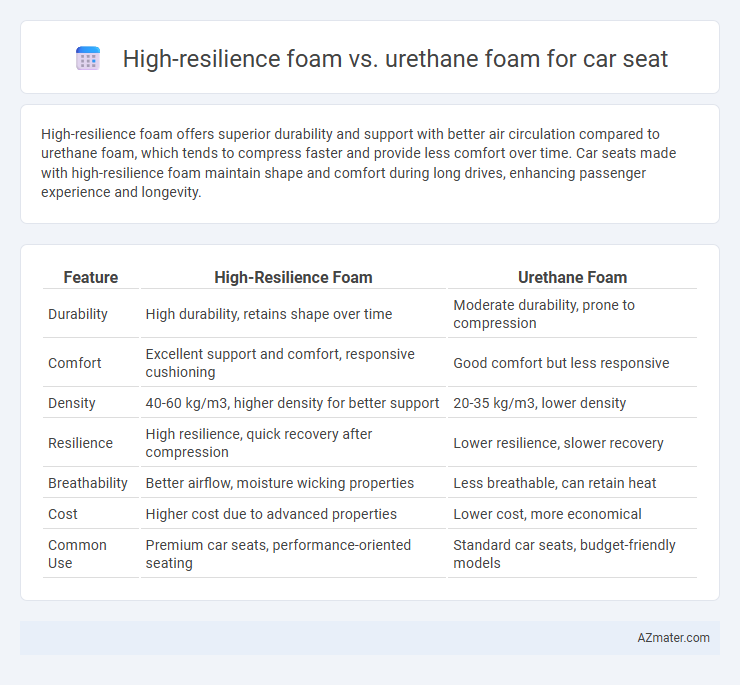High-resilience foam offers superior durability and support with better air circulation compared to urethane foam, which tends to compress faster and provide less comfort over time. Car seats made with high-resilience foam maintain shape and comfort during long drives, enhancing passenger experience and longevity.
Table of Comparison
| Feature | High-Resilience Foam | Urethane Foam |
|---|---|---|
| Durability | High durability, retains shape over time | Moderate durability, prone to compression |
| Comfort | Excellent support and comfort, responsive cushioning | Good comfort but less responsive |
| Density | 40-60 kg/m3, higher density for better support | 20-35 kg/m3, lower density |
| Resilience | High resilience, quick recovery after compression | Lower resilience, slower recovery |
| Breathability | Better airflow, moisture wicking properties | Less breathable, can retain heat |
| Cost | Higher cost due to advanced properties | Lower cost, more economical |
| Common Use | Premium car seats, performance-oriented seating | Standard car seats, budget-friendly models |
Overview of High-Resilience Foam and Urethane Foam
High-resilience foam features a higher density and superior elasticity, providing enhanced durability and support in car seats compared to traditional urethane foam. Urethane foam typically offers a softer feel but may compress faster, leading to reduced comfort and longevity. The advanced cellular structure of high-resilience foam ensures better weight distribution and resistance to deformation over time.
Material Composition and Manufacturing Process
High-resilience (HR) foam typically consists of a polyether-based polyurethane with a higher density and more uniform cell structure, providing superior elasticity and durability compared to standard urethane foam, which is often made from a less dense polyester or polyether blend. The manufacturing process for HR foam involves a more controlled foaming reaction with precise temperature and catalyst management to achieve its open-cell structure, enhancing breathability and support. In contrast, urethane foam production is less complex, relying on varied chemical formulations and molding techniques that can result in less consistent firmness and resilience.
Comfort and Support Characteristics
High-resilience foam offers superior comfort in car seats due to its excellent elasticity and quick recovery, providing enhanced support by evenly distributing body weight and reducing pressure points. Urethane foam, while cost-effective, tends to have lower durability and can compress faster, leading to diminished support and comfort over time. The dense structure of high-resilience foam ensures long-lasting cushioning and maintains seat shape, improving driver and passenger comfort during prolonged use.
Durability and Lifespan Comparison
High-resilience foam offers superior durability compared to urethane foam due to its higher density and faster recovery rate, which resists permanent deformation under prolonged use. This type of foam maintains its supportive properties and structural integrity over a longer lifespan, often exceeding 10 years in automotive seating applications. In contrast, urethane foam tends to degrade faster, losing cushioning ability and compressing more quickly under constant stress, resulting in a shorter effective lifespan of approximately 5 to 7 years.
Weight and Density Differences
High-resilience foam used in car seats typically has a lower density, around 1.8 to 2.5 pounds per cubic foot, offering lighter weight while maintaining superior durability and rebound compared to standard urethane foam, which often ranges from 2.5 to 3.5 pounds per cubic foot. The lower density of high-resilience foam contributes to reduced overall seat weight, improving vehicle fuel efficiency and handling, whereas urethane foam's higher density provides firmer cushioning but adds bulk and weight. These variations in foam density and weight significantly impact automotive seat design priorities such as comfort, support, and vehicle performance.
Cost Analysis for Car Seat Applications
High-resilience foam typically costs more upfront than urethane foam but offers superior durability and longer lifespan, reducing replacement frequency in car seat applications. Urethane foam presents a lower initial cost, making it attractive for budget-conscious manufacturers, though it may degrade faster under continuous use, leading to higher long-term expenses. When analyzing total cost of ownership, high-resilience foam often proves more economical due to enhanced comfort retention and maintenance savings in automotive seating.
Breathability and Temperature Regulation
High-resilience foam offers superior breathability compared to urethane foam due to its open-cell structure, which promotes airflow and reduces heat buildup in car seats. This enhanced ventilation capability helps maintain a cooler surface temperature, improving passenger comfort during long drives or in hot climates. Urethane foam, while providing adequate cushioning, tends to trap heat and moisture, leading to a warmer seating experience with less effective temperature regulation.
Safety and Fire Resistance Ratings
High-resilience foam offers superior safety due to its enhanced durability and ability to better absorb impact compared to urethane foam, reducing injury risk during collisions. High-resilience foam typically meets higher fire resistance standards such as California Technical Bulletin 117-2013 (TB117-2013) due to its denser cell structure and fire-retardant additives. Urethane foam often falls short in fire resistance ratings and may release toxic fumes under combustion, making high-resilience foam the preferred material for safer, fire-compliant car seats.
Environmental Impact and Sustainability
High-resilience foam in car seats offers superior durability and longer lifespan compared to traditional urethane foam, reducing the frequency of replacement and overall material waste. Urethane foam typically involves petrochemical production processes with higher carbon emissions and limited recyclability, whereas advances in high-resilience foam manufacturing increasingly utilize bio-based polymers and eco-friendly additives to improve sustainability. The enhanced performance and evolving green technologies in high-resilience foam contribute to a lower environmental impact through energy-efficient production and potential for end-of-life recycling.
Best Applications for Each Foam Type in Automotive Seating
High-resilience foam, known for its superior elasticity and durability, is ideal for automotive seating requiring long-lasting comfort and support, making it best suited for premium car seats and performance vehicles. Urethane foam, with its versatile density options and cost-effectiveness, excels in standard car seats where moderate cushioning and durability are sufficient. Each foam type enhances seat ergonomics differently, with high-resilience foam providing enhanced weight distribution and urethane foam offering efficient cushioning at a lower price point.

Infographic: High-resilience foam vs Urethane foam for Car seat
 azmater.com
azmater.com